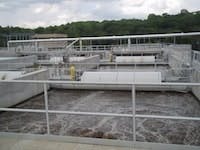Economic development has its price, and sometimes it calls for major upgrades to a community’s wastewater treatment facilities.
That was the case in Fort Dodge, Iowa. Expansion of new Cargill and CJ Bio America plants in the nearby Iowa Crossroads of Global Innovation industrial park—resulting in 300 new jobs—has required additional capacity and biochemical oxygen demand (BOD) and total Kjeldahl nitrogen (TKN) removal capabilities at the Fort Dodge Water Pollution Control Facility (FDWPCF).
The two agricultural production plants have added about 5 million gal per day (mgd) of flow to the FDWPCF, and have increased BOD and TKN loadings by 100% and 300%, respectively. To meet the new treatment requirements, Fort Dodge chose to expand the biological treatment technology it had been using for several years—the Vertical Loop Reactor (VLR) process from the Envirex product group of Evoqua.
Essentially an oxidation ditch tipped on its side, the VLR not only saves on construction costs and footprint requirements when compared to conventional treatment, it gives the Fort Dodge plant the ability to simultaneously nitrify and denitrify.
“We selected VLRs back in 1998 when we faced new ammonia limits,” said Mike Trotter of McClure Eng. Co., Fort Dodge, the design firm on the project. “We decided to install suspended growth biological technology to replace our old two-stage trickling filters.
“We looked at several biological processes, and the VLR offered more flexibility,” he said, noting that the design team and the city were looking ahead to anticipated nutrient removal requirements in the future.
Two VLRs were installed back then, and a third has been added in the new project, which also includes a new final clarifier, pumping stations, aerobic digester, and blower and chemical building, plus rehabilitation of the existing ultraviolet (UV) disinfection system.
The total project cost was $23 million, and the contractor was Gridor Construction of Buffalo, Minn. US Water operates the plant for the city.
Plant Flow
The capacity of the new facility is 12 mgd for primary treatment, and 18.6 mgd for secondary. While the flow from the CJ Bio America operation enters the plant at the headworks, primary or secondary stage, the flow from Cargill is treated at the manufacturer’s site and sent directly to the FDWPCF disinfection step.
Influent passes through a flow splitter and the screening and grit removal facility before settling in two 90-ft diameter, 12-ft-deep primary clarifiers. Biological treatment in the VLRs follows, before the treated water is clarified in a trio of 100-ft diameter, 16-ft-deep circular secondary basins.
Flow is disinfected with UV light before discharge to the Des Moines River. An effluent pumping station prevents flooding during high water conditions on the river.
The high ammonia content of agricultural plant wastewater and the long detention time in the force main to the plant has required the FDWPCF to use a magnesium hydroxide product called Thioguard (Martin Marietta Magnesia Specialties) to supplement alkalinity, and control odors and corrosion.
Solids are aerobically digested, decanted and then pumped to a settling lagoon. Contents are removed every couple of years and the material is spread on area farmlands.
All plant processes are controlled by a SCADA system.
VLR Technology
Each VLR train includes four tanks. In the first two tanks, mechanical aeration by Envirex disc aerators from Evoqua is closely controlled to create anoxic conditions (zero dissolved oxygen) and maintain the desired ORP (oxidation reduction potential). In the third and fourth tanks, the discs run at a constant speed to sustain aerobic conditions. Coarse bubble diffusers are controlled by Aerzen hybrid blowers, which regulate dissolved oxygen (DO), facilitating simultaneous nitrification and denitrification.
Contents from the fourth tank in each VLR are recycled to the first and second tanks to supplement total nitrogen removal. Overall, up to 90% to 95% removal is achieved.
Trotter points to the flexibility of the process, noting that the plant can control power usage on each of the three VLRs, and can split, block or proportionately distribute return activated sludge according to wastewater characteristics and treatment objectives. He says that normally, the plant operates at 2 mg/L DO out of the final tank, with additional DO added as the water passes over the finger weirs in the UV system.
A new “smart” biological nutrient removal (BNR) control system, supplied by Evoqua, uses DO and ORP monitors in each tank to control the operation of the discs, blowers, and internal recycle pumps.
Trotter also noted that the VLR installation will enable the plant to remove phosphorus biologically (if required in the future) without having to add any more tanks.
The schedule for the project was tight. Trotter said Cargill approached the city with its expansion plans in 2011, and McClure Eng. had completed the plant upgrade design by the end of that year. Bidding took place between May and October 2012, with substantial completion by the end of 2013, and final completion by mid-2014.
At the moment, it is not clear whether more production facilities will be added to the industrial park, but if they are, the FDWPCF will be prepared. “The VLR is the best application for dealing with total nitrogen and phosphorus limits in the future,” Trotter said.
Jim Force is a freelance writer on water and wastewater topics, based in Wausau, Wis. For questions, please contact Mark Pamperin, product manager, biological processes with Evoqua Water Technologies at [email protected] or 262.521.8263.



